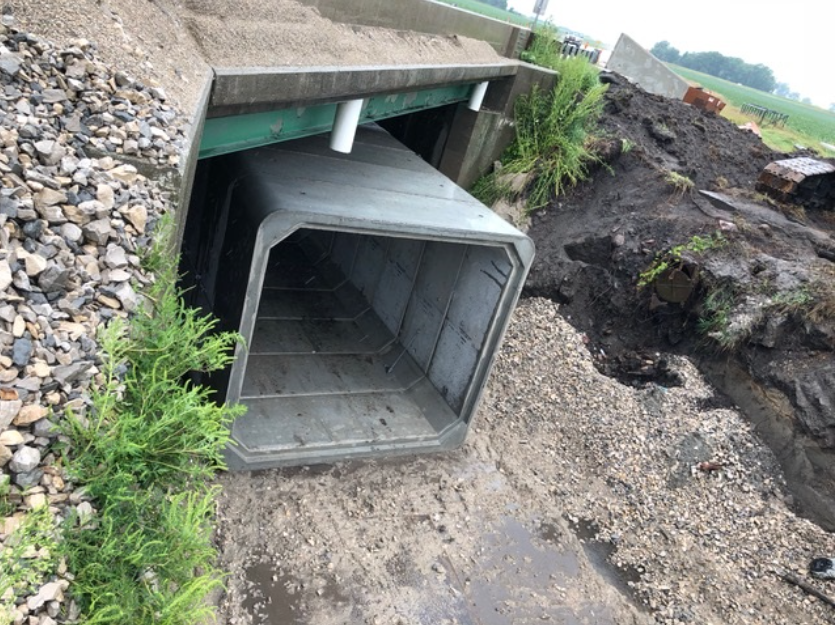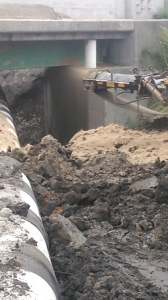Precast Box Culvert Extends Bridge's Service Life

12- by 11-foot precast concrete box sections slid under bridge to form culvert.
Peterson Contractors Inc. of Reinbeck, Iowa, was contracted to install the 12’ x 11’ precast concrete box sections, encompassing 125 linear feat plus end sections, under the 36’ span, I-beam bridge to construct a culvert for channelling the free-flowing North Racoon River. By containing the waterway in the box culvert, erosion of the soil support for the bridge structure was mitigated while controlling local flooding that could interrupt traffic.
Although a crane typically places a box culvert at project sites, a crane couldn’t position the culvert underneath the bridge deck for the project. Instead, the contractor used a large 980 Caterpillar loader with forks to offload the box sections, slide the boxes under the bridge and assemble the culvert.

Culvert installed at a 45-degree angle to the roadway alignment to follow alignment of creek.
In addition, the culvert’s design was a special consideration because the culvert alignment was at a 45-degree angle to the alignment of the road – a more difficult construction than the 90-degree angle that’s typical for box culvert installations. In the Buena Vista County project, the 45-degree angle was necessary to follow the stream’s configuration and improve the flow in the creek’s channel.
Farmers, like those who traverse the bridge in Buena Vista County, have become advocates for replacing or rehabilitating small bridges with precast concrete culverts. Because culverts extend the clear zone, farmers don’t have to contend with guardrails when they move equipment from field to field. With a precast concrete culvert, farm equipment can’t damage guardrails, snow drifting is reduced, the structure’s maintenance is minimized, and the safety of the crossing is enhanced.

The contractor removed the guardrails from the bridge and filled the void between the box and bridge structures with flooded sand to the top of the box. Flooded backfill is a standard Iowa specification, which consolidates the material to decrease settling. The contractor backfilled the sides of the box with sand and then flooded it so it could settle and become 100-percent dense.
Eighteen holes were then cored in the bridge deck for pouring flowable mortar to fill the void between the top of the box and the bottom of the bridge. The box culvert that extended from underneath the bridge was covered with clay. The contractor revisited the fill operation a week later to add fill to any remaining voids. Due to precast concrete’s ability to accelerate construction processes, the box culvert was installed in only three days during the week of August 17, 2018.
| Contractor Peterson Contractors Inc. Cork Peterson, Owner Jamie Thomas, Superintendent Jordan Krull, Estimator Tom Ackerman, Installation |
Owner Iowa Department of Transportation Jim Nelson, Bridge Engineer Dean Bierwagon, Structural Patricia Schwarz, Hydraulics Mark Dell, Geotechnical Yanziao Jia, Roadway Dave Claman, Preliminary Bridge |
Photos: Courtesy of Hancock Concrete Products
Flooded sand used to fill void to top of culvert and clay used to cover culvert extending beyond bridge deck.

